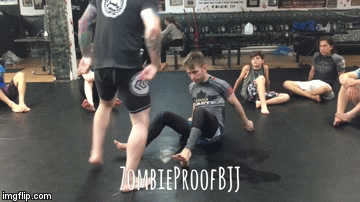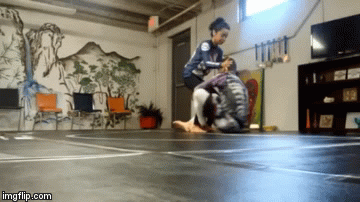
Okay, officially, the leg lock craze has somewhat died down. No matter where you train, you’re bound to run into leg locks in BJJ nowadays. However, that’s not a prospect that’s nearly as scary as before. The more people do leg locks, the more other people get used to them and find ways to solve the riddle. That means that leg locker, at least the really dedicated ones, need to figure out a way to get the advantage back. When pure technique runs into a wall, you need to turn to speed and surprise to tip the scale to your favor. In other words, you need to learn a few spinning leg lock entries.
Leg locks are definitely among the most powerful and certainly high percentage submissions in all of the martial arts. However, the latest leg lock revolution that presented them as parts of an in-depth positional system has now caught on. Nowadays, people do not panic when they get caught in an Ashi Garami, which is the main difference e compared to before. To that extent, leg locks are still highly effective when you have the position and the grips. However, getting there can be a real challenge nowadays, particularly against slippery escape artists. Innovating with leg lock entries is one great way of becoming much more efficient.
Leg Locks Are Nothing New
The moment leg locks burst onto the grappling scene, people were divided. I know, because I was one of them. Coming from a traditional Gi-based BJJ academy, I really disliked even thinking about leg locks. Then, through a series of events, I ended up giving them a try. Needless to say, I got hooked. AS did most of the BJJ community, particularly all the No-Gi enthusiasts.
What Danaher’s leg lock philosophy did, was a real slap in the face for most grapplers. Where many people saw just submissions, he saw complete Jiu-Jitsu. By developing and naming specific positions to attack from, the Danaher system took everyone by surprise. Understandably, everyone immediately turned their attention to leg locks. However, as with most things in BJJ, the leg lock trend is slowly coming to a close. The reason is not that everyone learned how to do them to perfection. The reason is that most people are no aware of them. Since most do not want to commit to really understanding them, they run into defenses and counters now and slowly start to look for other “unstoppable” moves.
For all the die-hard leg lockers though, this is just another problem to solve. And a very welcome one at that. As I stated before, leg locks are no less effective than they were. IF you get to the cross Ashi Garami position, you’ll most likely get a tap. If you have good heel hook grips to go with it, you’ll get it immediately. The problem is getting to the position, as most leg lock entries are now very well known. The time for innovation, it seems, is in the leg lock entries department. Or, perhaps, we could look in a different direction than trying to re-invent the wheel?
The Surprise Factor
In all warfare, strategy and tactics are key. One of the best tactics over time has proven to be deception. In essence, this is a core principle of Brazilian Jiu-Jitsu as well. Whenever you’re face to face with an enemy, deception is the best way of achieving victory. That said, deception is a very wide and encompassing principle. One of the tactics that are available through deception Is the element of surprise.
Do you know that saying “calm before the storm”? Well, it can be used to very accurately describe the element of surprise as a tactical and strategic advantage. In warfare, it has many variations and possible scenarios. In BJJ, on the other hand, things are much more straightforward. The point is to use surprise as a factor to get you where you want to be. In that sense, surprise can be technique, speed, direction change, etc. In terms of leg lock entries, it is actually a blend of speed and unexpected movement. This is the recipe that’ll confuse your opponents and get you to a position where a tap is inevitable.
To that extent, spinning entries are by far the best possible option. They are hard to predict, available from different positions, and virtually impossible to stop once initiated. They’re the perfect storm that comes after the calm – as long as you’re willing to go for them.
Cool Spinning Leg Lock Entries
The goal of spinning leg lock entries is to get you into an Ashi Garami fast. As opposed to simpler directional attacks, they’re hard to predict and hard to prevent. Plus, they’re extremely quick once you get sued by them. The one downside is that you need to put in a lot of repetitions and drilling in order to get proficient with them. A huge benefit, though, is that once you’re an expert, you can even catch people that know exactly what you’re about to do. That is high-level Jiu-Jitsu at its best.
The options I offer below are far from the only options available. Moreover, they might also not be the best possible spinning leg lock entries in existence. They’re just a few surprising ways that I like to rely on when the more methodical approach doesn’t;’ yield results. Oh, and despite me hating to talk about legal and illegal leg locks, I did include all kinds of options that work under any ruleset.

The Spinning Knee Bar
Speaking of universally effective submissions, there’s hardly one better than the kneebar. The only catch is that you need a brown belt or higher to do them under IBJJF rules. That said, this does not stop you from practicing them even earlier than that. the entry we’ll cover today is a classic that people often get wrong – the half guard spinning kneebar.

The Top Position Half Spin

When you’re trying to get to the Cross Ashi Garami position from a guard pass, you need to step as deep as possible with your leading leg. Then, as you spin, you need to make sure that the goal is to stick your knee behind the opponent’s knee, as opposed to just spin as much as you can. That is why this is more of a half-spin than a complete one. It is incredibly efficient, though, and does provide one of the fastest leg lock entries available in the game.
The Outside Ashi Spinning Entry

Once your opponent’s hips hit the mats be ready to use the momentum they provide you with, Make sure you have a strong connection to their leg and use it to place your knees on the ground and spin around directly into the Cross Ashi Garami. From there, you can either hit a kneebar or go deep and hunt for the usual heel hooks.
A Spinning Armbar Counter
I have to admit, this is a leg lock entry that has gotten me out of some really tight spots. However, before I go into it, know that you’ll need to have at last some rudimentary armbar defense if you’re to mess with this one. That said, it works like a charm once you get the hang of it.

The Imanari

The next crucial moment is the connection of your legs to their hips. This happens mid-spin, though. Before that, you need your legs to initiate momentum, not unlike when doing an armbar from the bottom. Also, remember to spin on your upper back rather than looking to roll over the neck. This makes the movement much faster and much more effective.
Wrapping up
Whichever way you choose to approach spinning leg lock entries, you can bet they’ll massively increase your finishing rate. As long as you have the basics of leg locking positions down, fast and surprising entries are going to ensure you get what you want. Time to start spinning!


![Darce Choke Encyclopedia – Origins, Mechanics and Variations [2024] BJJ, choke, Brabo, BJJ Darce Choke, D'arce Choke, Darce BJJ Choke](https://bjj-world.com/wp-content/uploads/2017/11/JungPoirierLeeYahoo-218x150.jpg)









![Front Headlock and Turtle Escapes Brian Glick DVD Review [2024] Front Headlock and Turtle Escapes Brian Glick DVD Review](https://bjj-world.com/wp-content/uploads/2024/11/headlock-and-turtle-escapes-brian-glick-dvd-review-218x150.png)
![Basic Closed Guard Jasmine Rocha DVD Review [2024] Basic Closed Guard Jasmine Rocha DVD Review](https://bjj-world.com/wp-content/uploads/2024/11/basic-closed-guard-jasmine-rocha-dvd-review-218x150.png)
![Don’t Stand Up Chris Wojcik DVD Review [2024] Don't Stand Up Chris Wojcik DVD Review](https://bjj-world.com/wp-content/uploads/2024/11/dont-stand-up-chris-wojcik-dvd-review-218x150.png)
![EMU Guard 2.0 Benjamin Power DVD Review [2024] EMU Guard 2.0 Benjamin Power DVD Review](https://bjj-world.com/wp-content/uploads/2024/11/emu-guard-2-0-benjamin-power-dvd-review-218x150.png)
![The Whole Omoplata Enchilada Lyanne Perez DVD Review [2024] The Whole Omoplata Enchilada Lyanne Perez DVD Review](https://bjj-world.com/wp-content/uploads/2024/11/whole-omoplata-enchilada-lyanne-perez-dvd-review-218x150.png)
![No-Gi Defense Xande Ribeiro DVD Review [2024] No-Gi Defense Xande Ribeiro DVD Review](https://bjj-world.com/wp-content/uploads/2024/11/no-gi-defense-xande-ribeiro-dvd-review-218x150.png)




![Crossing and Spinning Steps To Attack Israel Hernandez DVD Review [2024] Crossing and Spinning Steps To Attack Israel Hernandez DVD Review](https://bjj-world.com/wp-content/uploads/2024/09/spinning-steps-to-attack-israel-hernandez-dvd-review-100x70.png)




![Front Headlock and Turtle Escapes Brian Glick DVD Review [2024] Front Headlock and Turtle Escapes Brian Glick DVD Review](https://bjj-world.com/wp-content/uploads/2024/11/headlock-and-turtle-escapes-brian-glick-dvd-review-100x70.png)
![Charles Allan Price Building Workouts For BJJ DVD Review [2024] Charles Allan Price Building Workouts For BJJ DVD Review](https://bjj-world.com/wp-content/uploads/2024/09/charles-allan-price-building-workouts-for-bjj-review-100x70.png)




![Dubious De La Riva Dominique Bell DVD Review [2024] Dubious De La Riva Dominique Bell DVD Review](https://bjj-world.com/wp-content/uploads/2024/10/dubious-de-la-riva-dominique-bell-dvd-review-100x70.png)


![The Whole Omoplata Enchilada Lyanne Perez DVD Review [2024] The Whole Omoplata Enchilada Lyanne Perez DVD Review](https://bjj-world.com/wp-content/uploads/2024/11/whole-omoplata-enchilada-lyanne-perez-dvd-review-100x70.png)
![Osoto Gari for Jiu Jitsu Jackson Nagai DVD Review [2024] Osoto Gari for Jiu Jitsu Jackson Nagai DVD Review](https://bjj-world.com/wp-content/uploads/2024/10/osoto-gari-for-jiu-jitsu-jackson-nagai-dvd-review-100x70.png)

![Modern Split Squat Passing Jason Rau DVD Review [2024] Modern Split Squat Passing Jason Rau DVD Review](https://bjj-world.com/wp-content/uploads/2024/11/modern-split-squat-passing-jason-rau-dvd-review-100x70.png)





![Assassin Choke Baret Yoshida DVD Review [2024] Assassin Choke Baret Yoshida DVD Review](https://bjj-world.com/wp-content/uploads/2024/10/assassin-choke-baret-yoshida-dvd-review-100x70.png)

![Intro To Hip Mobility for Guard Players Joshua Presley DVD Review [2024] Intro To Hip Mobility for Guard Players Joshua Presley DVD Review](https://bjj-world.com/wp-content/uploads/2024/09/hip-mobility-for-guard-joshua-presley-dvd-review-100x70.png)